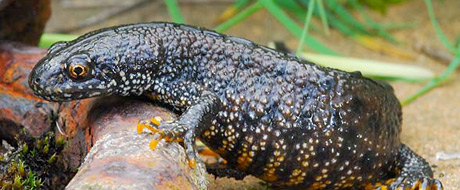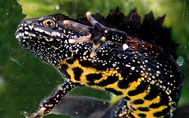
NEWTS
Great Crested Newts (Triturus cristatus)are Britain’s largest newt species, growing up to 17cm long (body and tail) They are dark, often black, patterned with small white spots and orange bellies. Males develop a high serrated crest during the breeding season and have a white flash running along their tails. Although now afforded legal protection in the UK, populations have declined over recent years as a result of the destruction and fragmentation of their habitat.
General Information
Great Crested Newts (Triturus cristatus)are Britain’s largest newt species, growing up to 17cm long (body and tail) They are dark, often black, patterned with small white spots and orange bellies. Males develop a high serrated crest during the breeding season and have a white flash running along their tails. Although now afforded legal protection in the UK, populations have declined over recent years as a result of the destruction and fragmentation of their habitat. Newts spend most of the year on land, moving around mainly in the hours of darkness so are rarely seen during the daytime. At the beginning of spring, when night temperatures start to creep over 100C, the adults return to still water to breed, travelling upwards of 1km to return to the breeding ponds. The female can lay upwards of 200 eggs, wrapping each one in a submerged plant leaf. In the late summer the newts leave the water, although some juveniles may over winter in the pond as larvae. As temperatures drop, the newts begin to hibernate on land in sheltered, damp, frost-free places including log piles, walls and under ground. Great Crested Newts do not reach breeding maturity until around their third year when they usually return to the pond they were born in.
Protection
The Great Crested Newt is listed on Schedule 5 of the Wildlife and Countryside Act 1981, recently modified by the Countryside and Rights of Way Act 2000. The Great Crested Newt is therefore subject to the provisions of Schedule 9, which makes it an offence to:
- Intentionally kill, injure or take a Great Crested Newt
- Possess or control any live or dead specimen or anything derived from a Great Crested Newt
- Intentionally or recklessly damage, destroy or obstruct access to any structure or place used as shelter or protection by a Great Crested Newt.
- Intentionally or recklessly disturb a Great Crested Newt while it is occupying a structure or place, which it uses for that purpose
The Great Crested Newt is also listed on Annex II and Annex IV of The Conservation (Natural Habitats & c) Regulations 1994. Regulation 39 makes it an offence to:
- Deliberately capture or kill a Great Crested Newt
- Deliberately disturb a Great Crested Newt.
- Deliberately take or destroy the eggs of a Great Crested Newt.
- Damage or destroy a breeding site or resting place of a Great Crested Newt.
The legislation applies to all life stages of Great Crested Newts.
The maximum fine on conviction of offences under Section 9 Regulation 39 currently stands at £5,000 per offence i.e. per Newt. The CroW Act 2000 amendment also allows for a custodial sentence of up to six months instead of, or in addition to, a fine. In addition, items, which may constitute evidence of the commission of an offence, may be seized and detained.


















